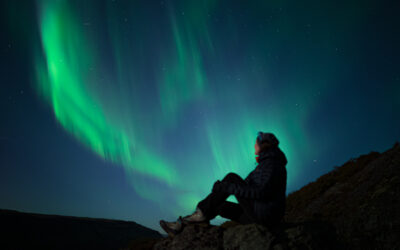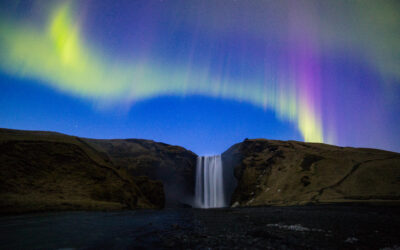ARE WE ENTERING SOLAR CYCLE 25?
Is the sun increasing in activity?
What is a solar maximum and when will it be?
Have we now passed the solar minimum?
What impact does this have for those wanting to discover the dazzling Northern Lights?
Find out the answers to these questions and more below.
By Chris Ayliffe

Northern Lights in Iceland, @aurorareykjavik
For Aurora enthusiasts, there’s been some great recent news in the past few weeks. Space Weather Live has reported about the possibility that we have now passed the recent solar minimum.
The data is certainly starting to look promising with even a recent M-Class flare being emitted from the sun for the first time since 2017.
Sadly for us in Iceland, though we have been blessed with some incredible clear skies, it’s the summer, and that means no Northern Lights for us. However, to quote the great Jon Snow: “Winter is coming”.
But what does this all mean? Well, I thought I’d explain a little more about the jargon, what the new data predicts for those visiting our lovely shores in the coming winters, and what this means for the ever sought after green lady.
As Iceland is one of the best places to see the Northern Lights, let me uncover why this upcoming aurora season is one not to miss.
Contents
In this blog I’ll cover the following:
What do Solar Minimum and Solar Maximum Mean?
Believe me, I know the jargon often gets super confusing, so let me break it down for you.
Solar minimum simply means the period in the sunspot cycle when solar activity is lowest, and sunspots are less abundant.
In plain English, this means the sun’s activity is at its quietest in its solar cycle and is producing less frequent crazily powerful knock-your-socks-off Northern Lights displays for us in the northern hemisphere.
Why is this?
Well, the sun is seen to follow a relatively consistent 11-year cycle where at solar maximum, the sun has a peak of sunspots, and at solar minimum they are at their lowest quantity.
We have now successfully measured 24 solar cycles, and now we could well be entering Solar Cycle 25, which is the predicted start of an increasing number of sunspots.

Just to break that down even further for you: sunspots are darker and cooler areas on the sun’s photosphere. They often appear as black dots on images we take of the sun and can be up to 50,000km in diameter (just like the image below).
They’re phenomena caused by interactions with the sun’s magnetic field which are not yet fully known.
Think of a sunspot as a loosened fizzy drink bottle cap. If you shake it up, you can generate a big eruption of energy (and that’s without adding a Mento!).
The sun is the same. Sunspots sit over regions of intense magnetic activity. When this energy is released, it can emit solar flares, enhanced solar wind and even huge storms otherwise known as coronal mass ejections.

Source: Space.com, 2020, Image: © BBSO
If these sunspots release energy when facing the Earth, there is a good chance of a great Northern Lights display. We just have to hope for clear and dark skies.
So, as you might have guessed, solar maximum is the point during the sunspot cycle when solar activity is at its highest and sunspots are at their most abundant.
During this period of the solar cycle, we anticipate a higher probability of intense aurora borealis displays here in Iceland as well as parts of Norway, Sweden, Finland, Russia, Canada and Alaska.
That’s not to say during the period of solar minimum, like the past winter, that Santa turns his magic lights off.
In this past season, we still had some incredibly jaw-dropping displays, like the picture captured below.
Just remember, though we’re getting better at predicting observations and measuring real-time data, anything can happen when you look to the dark skies during a winter in Iceland.
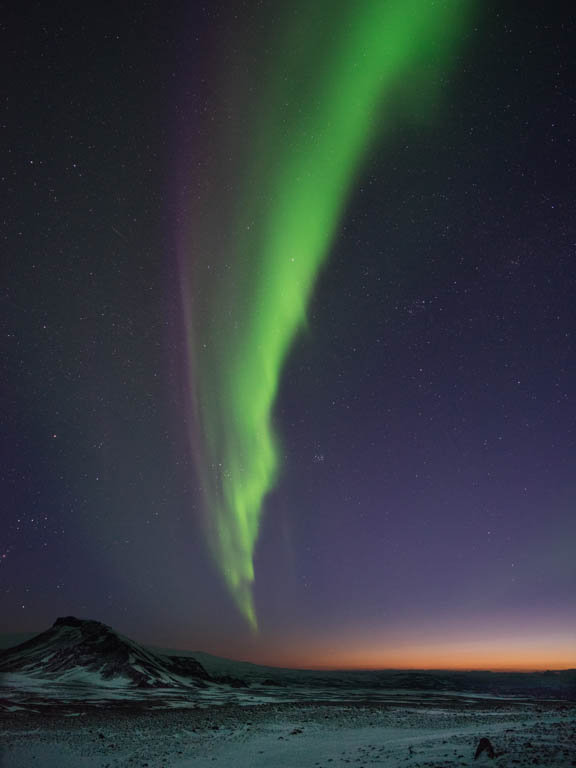
Northern Lights in March, @aurorareykjavik
When is the Next Solar Maximum Predicted?
The short answer is, the peak is expected between 2023 – 2026.
However, it is incredibly irregular that the sun emits an M-Class flare during solar minimum, like the one which happened recently.
This has got the moths, like myself, drawn to the North’s spectacular green lights, wondering if perhaps activity might start ramping up sooner and potentially more powerful than expected.
This level of activity is incredibly rare during a solar minimum. So with sunspots now hopefully on the increase in volume, let’s just see what surprises the sun has for our glorious skies come winter. You’ll have to be here to see it for yourself.
The predictions for the number of sunspots during the solar maximum of solar cycle 25 is to be broadly similar to solar cycle 24 — between 95 – 130 sunspots.
During the past Northern Lights season (September 2019 – April 2020) we recorded on average 2 sunspots per month; a broadly accurate metric you’d expect for a solar minimum.
For the next season, current predictions are anticipating an average of between 1.5 – 11 sunspots per month.
Having experienced numerous incredible displays last season, this data, combined with the recent flare, is already making me charge my extra camera batteries.
Though we can never be 100% on what to expect, which, believe me, means a lot of frantic runs to the car and some frozen-fingered camera setups, this season could be the start of some incredibly exciting displays over our skies in Iceland.
What Does the Data From the Past Show Us?
Let me start this section with a little bit of Northern Lights history.
Carrington Event
In September 1859, the world experienced what has become known as the most powerful geomagnetic storm recorded, named the Carrington event.
The incident was named after British astronomer, Richard C. Carrington, who recorded the event.
It occurred only a few months before the solar maximum of solar cycle 10 and was the result of an incredibly powerful coronal mass ejection smashing into Earth’s magnetosphere.
This not only delivered incredible Northern Lights viewing for those in the far North but was so powerful that even people in the Caribbean could see an incredible aurora borealis display dancing above their heads.
It’s even recorded that the lights were so bright that it actually woke up some gold miners in the US who started preparing breakfast for the day, thinking it was morning.
Predicting Solar Cycles
So, why am I telling you this?
Well, as mentioned earlier, the Sun is one tricky lady to predict.
Though statistical analysis allows us to assume a solar maximum has more chance of driving intense Northern Lights displays, it is merely a prediction.
What we can be relatively sure of is the Sun’s repetitive 11-year cycle as illustrated below with continuous measurements of observed sunspots.
We can take analysis from the past to predict the next solar maximum, and observe the sunspots as they arise.
However, in my experience, the sporadic and unpredictable intensity of the Northern Lights are not easy to predict.
Even in periods of solar minimum, like the previous season, we had a series of incredible shows that silently decorated our skies and lit up the ground beneath our feet.
Take predictions with a pinch of salt. Often the magic of the Northern Lights is the anticipation of heading out in the evening utterly unsure of what stunning sights you’ll see each night.
Life is an adventure, after all!
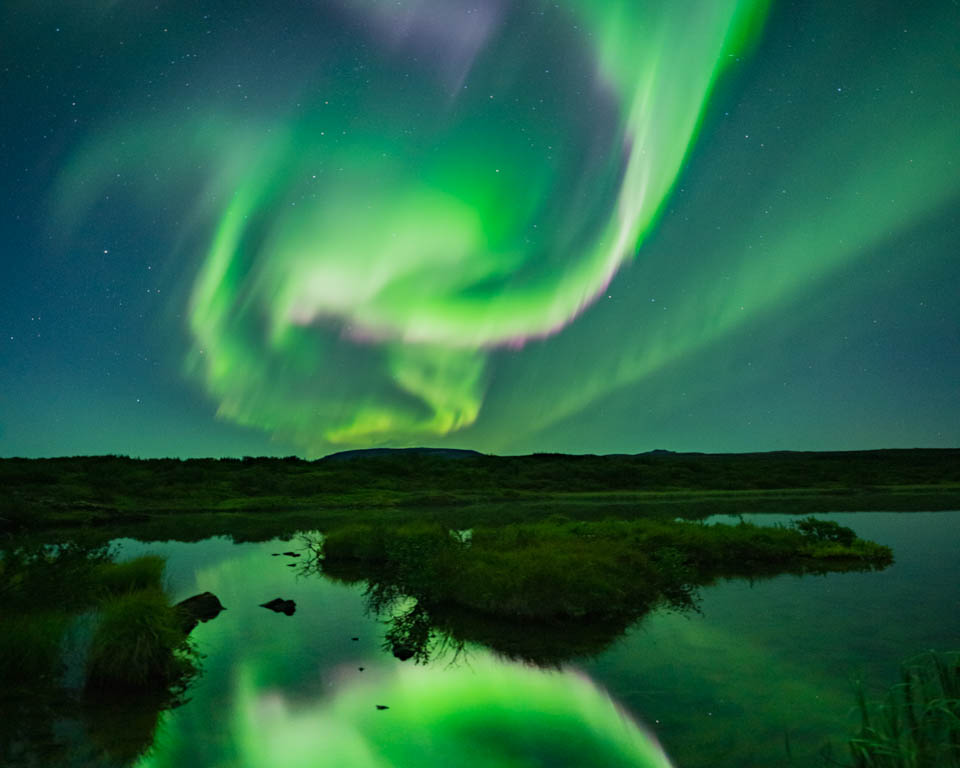
Outburst of Lights in September, Þingvellir National Park, @aurorareykjavik
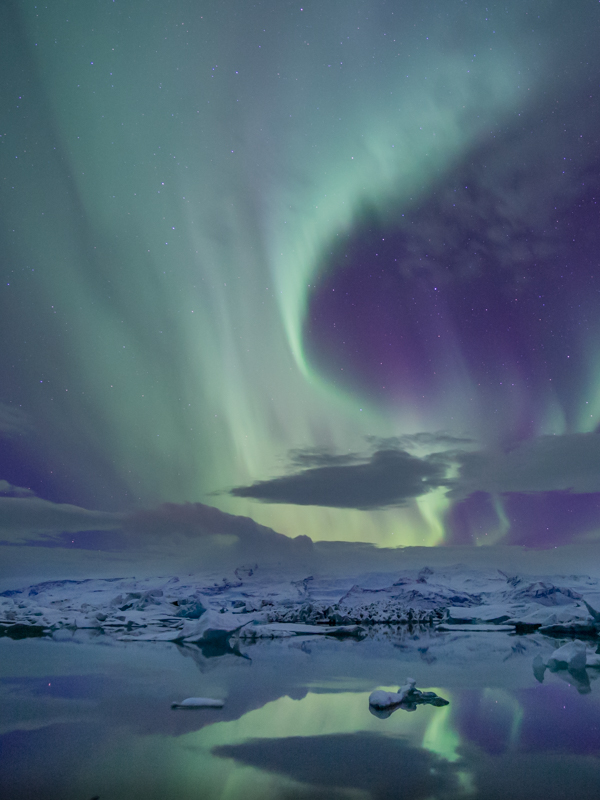
Winter Northern Lights at Jökulsárlón, @aurorareykjavik
What Does This Mean for Travellers Searching for the Northern Lights?
Don’t worry, even though we live on a rock in the middle of the Atlantic, we’re fully aware of the awful COVID-19 situation and its effect on both people and travel.
It’s been a hard time for everyone. Hopefully, the circumstances will start to decline soon so we can all start enjoying travel once more.
In Iceland, we’ll be welcoming travellers back from June 15th 2020 onwards.
Those planning on visiting will be required to either take a COVID-19 test at the airport, allowing safe travels within the country.
One thing is sure; however, if you’re coming to Iceland in winter, you’re definitely after a chance to see the Northern Lights, and who can blame you!
Iceland is the perfect Northern Lights destination
Iceland is not only one of the best places to witness the Northern Lights, but also has the unique array of incredibly diverse and unique locations from which to watch.
As I explained earlier, this season is expected to have an increase in the number of active sunspots, meaning the chances of spotting a glimpse of the bucket list item are growing.
If you’re coming over, why not maximise your chances even further by joining one of our expert guides on a tour to spot the dancing colours above.
With a variety of options for travellers to choose from, you can select which best suits you, and let us take care of the rest.
Your guides will explain both the science and folklore behind one of the best natural wonders of the world.
From the charming Finnish story of the running Arctic Fox and the Norse tales of the glinting armour of the Valkyrie preparing for a battle to a Brian Cox inspired scientific overview, these tours are designed to give customers the best possible experience under the Northern Lights in Iceland.
One thing is for certain, you can be sure we’re counting down the days of summer before the hunt starts once more, and we hope you’ll get to join us to make some incredible memories.
To give you an idea, here are a few sunrise and sunset times in Reykjavik during the winter:
December 1st: Sunrise at 10:45 am and sunset at 3:45 pm
December 15th: Sunrise at 11:15 am and sunset at 3:30 pm
January 1st: Sunrise at 11:19 am and sunset at 3:42 pm
January 15th: Sunrise at 10:56 am and sunset at 4:18pm
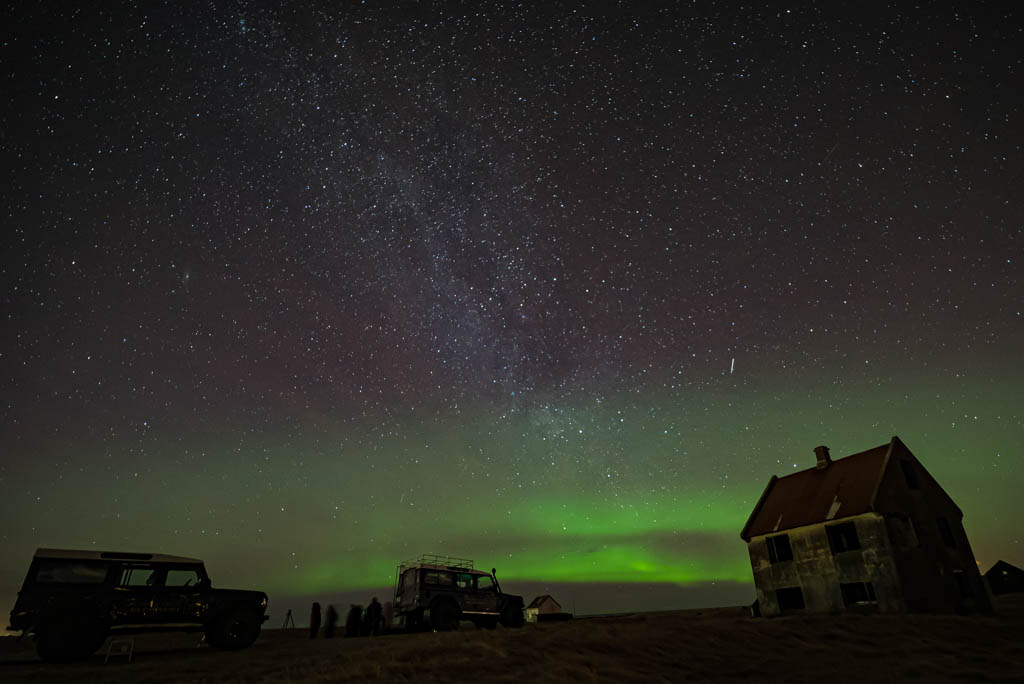
Check out this Northern Lights tour on modified Landrovers – those guys truly lead the pack when it comes to stargazing in Iceland

Northern Lights at Kirkjufell in March, @aurorareykjavik
When Should You Come to Iceland to See the Northern Lights?
As you can tell by now, I’m a big fan of statistics and graphs.
Statistically speaking the best times of year to watch the Northern Lights in Iceland are near the Autumn and Spring Equinoxes (September 22nd and March 20th).
Now, this isn’t just some campfire estimation; there is, in fact, a little known scientific theory behind why these times of year are particularly fantastic for aurora activity.
Russell McPherron Hypothesis
During the equinox, there is usually heightened geomagnetic electrical disturbance as the Earth’s axial tilt aligns us at the peak angle relative to the sun. This, therefore, increases the chances of the Earth receiving sun particles which cause the aurora borealis.
This is known as the Russell McPherron hypothesis.
The hypothesis explains how both the sun and the Earth’s geomagnetic field and solar winds come into strong alignment from the increased geomagnetic electrical disturbance during these times of year combined with the perfect tilted position of the Earth’s axis.
This leads to an increased chance of the sun’s particles entering our atmosphere, which leads to Northern Lights displays.
“Look Up at the Stars and not Down at Your Feet”
In human words, this is fundamentally a great time to come to Iceland to increase your chances further of seeing the Northern Lights.
However, that’s not to say the sun switches off the night light during the other six months of potential Northern Lights visibility.
Hours of darkness continue to increase in Iceland until the 21st December, giving you more hours to hunt the skies above.
In the past year, I have seen great dances of the Northern Lights on my commute to work, my way home from work and several times with a nice warm drink on my balcony in downtown Reykjavík.
As every night brings an entirely different dance and show, the anticipation and excitement don’t dampen down even if you’ve witnessed nature’s greatest show countless times.
Part of the excitement of visiting Iceland during the aurora season is not being fully aware of what each night might truly bring.
The only way to find out is to join an adventure in Iceland, and to quote the late great Stephen Hawking: “remember to look up at the stars and not down at your feet”.

Photo from our 4 day northern lights winter package
Conclusion
It’s likely we have now passed solar minimum, and the start of solar cycle 25 may have already begun. Recent activity and predictions seem to indicate there is a strong statistical chance of this.
For the passionate aurora hunters among you, this brings great excitement and hope for what the season ahead will bring us.
At particular times of struggle around the planet, a magical Northern Lights display can provide a rare moment of beauty and wonder for those lucky enough to find themselves witnessing it. Taking a breath under the greatest wonder above can be the perfect remedy to find peace, clarity and perspective during any period of stress.
So, whether we are, in fact, entering solar cycle 25 or not, the sheer unpredictability and shocks the sun and our skies can give us make the anticipation of the upcoming aurora season grow each day. I, for one, am already packing my camera.
Did you make up your mind when to travel to the arctic circle? Check out our Ultimate Guide to Seeing the Northern Lights – we get you set!
10 Night Sky Events not to be missed in 2025
10 Night Sky Events Not To Be Missed in 2025 From a partial solar eclipse to eye-catching planetary alignments and disappearing rings of Saturn, 2025 will be a year filled with celestial wonders that no stargazer should miss. As Aurora and night sky specialists in...
THE ULTIMATE GUIDE TO SEEING THE NORTHERN LIGHTS IN ICELAND IN 2025
Planning to see the Northern Lights in Iceland? This ultimate guide covers everything you need to know: the best time and places to see them, how to enhance your chances, what to bring, and how to capture stunning Aurora photos. From guided tours to self-drives, we’ve got you covered to make your Aurora hunt a success!
Help! It’s Full Moon! Will It Ruin My Aurora Experience?
Think a full moon will spoil your chances of seeing the Northern Lights? Think again! Discover why moonlit nights can enhance the aurora experience, from magical landscapes to stunning photography tips. Learn how to make the most of your Northern Lights hunt—even under a bright moon.
What Are The Main Types of Northern Lights?
Despite their enchanting beauty, not all auroras are created equal. They come in various forms, each with its own unique characteristics and charm.
This guide delves into the main types of Northern Lights, explains the science behind their differences, and offers tips for maximizing your chances of seeing them at their most spectacular.
Do the Northern Lights Occur Every Night?
The Northern Lights, or aurora borealis, are a breathtaking natural phenomenon that occurs every night. However, visibility depends on key factors like solar activity, weather, and location. Discover when, where, and how to maximize your chances of seeing the aurora, with expert tips and real-time tools. Whether you’re in Iceland or elsewhere near the auroral oval, this guide will prepare you for an unforgettable Northern Lights adventure!
How Long Do the Northern Lights Last?
Northern Lights displays are as unpredictable as they are awe-inspiring. Some nights, they light up the entire sky for hours, while on others, they may appear for only a few minutes – sometimes in a much softer glow. But, more often it can come in waves of intensity known as Substorms.
Let’s take a deep dive into the science, timing, and some of the most thrilling insights to help you understand what goes into the length of an aurora show, and maybe give you a better chance of witnessing one of nature’s greatest spectacles.
How to Read an Aurora Forecast: Your Complete Guide to not miss the Northern Lights
Catching the aurora isn’t just a matter of luck; it’s a combination of being in the right place at the right time and understanding the science behind the aurora forecast.
This guide goes beyond the basics, explaining every key element of an aurora forecast so you can maximise your chances of experiencing this incredible natural phenomenon for yourself.
THE 10 BEST NORTHERN LIGHTS ACCOMMODATIONS IN ICELAND IN 2025
Seeing the northern lights dance in the Icelandic sky is every traveler’s dream. Although the phenomenon can be seen anywhere around the country, light pollution sometimes spoils the view.
By opting for a full-comfort countryside northern lights stay, you will maximise your chances of success – literally at your doorstep.
Here are our 10 favourite country accommodations for seeing the northern lights in 2025.
Can You See the Northern Lights with the Naked Eye?
Yes, you can absolutely see the northern lights with the naked eye—under the right conditions! While cameras often pick up more detail and intensity than our eyes, a strong aurora combined with dark skies and clear weather can create an unforgettable spectacle visible to anyone looking up. In this guide, we’ll share tips to maximize your chances of experiencing the magic firsthand, no special equipment required!
The 25 Best Places To See The Northern Lights In Iceland
As a lifelong Northern Lights enthusiast and founder of Aurora Reykjavík, I’ve spent countless nights chasing the auroras across Iceland. Each experience feels like the first—an awe-inspiring dance of color and light against the vast Icelandic skies. In this guide, I’ll share my 25 favorite spots to witness this natural wonder, from remote highlands to coastal gems. Whether you’re a first-time visitor or a seasoned aurora hunter, these locations offer something truly magical. Let me take you on a journey to the best places in Iceland to see the Northern Lights. – Grétar Jónsson

